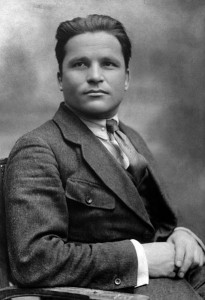
Sergei Mironovich Kirov was assassinated on December 1st 1934, likely by orders from his rival Joseph Stalin. Charismatic, good looking, and well liked, Kirov was a definite threat to Stalin who was trying to consolidate his power at the time. At the 1934 party congress, Kirov received only 3 negative votes whereas Stalin received far more. Unfortunately for Kirov, Stalin controlled the vote tally and he was elected instead of Sergei.
Born on March 27, 1886 as Sergei Mironovich Kostrikov, Kirov was orphaned at a young age and was sent to an orphanage at the age of 7. His education was paid for by wealthy benefactors which allowed him to graduate from an industrial school in Kazan where he received an engineering degree. He quickly became a Marxist as Russian society faced the crises of the early 1900’s.
After being arrested during the 1905 revolution, Kirov joined the Bolshevik party. He fought with the Bolsheviks in the Civil War as a commander in Astrakhan. According to Montefiore, “During the Civil War, Kirov was one of the swashbuckling commissars in the North Caucasus beside Sergo and Mikoyan. In Astrakhan he enforced Bolshevik power in March 1919 with liberal blood-letting: over four thousand were killed. When a bourgeois was caught hiding his own furniture, Kirov ordered him shot.”
In 1921 Kirov took a managerial post in the Communist Party in Azerbaijan as a loyal ally of Joseph Stalin. For this he was awarded the position as head of the Communist Party in Leningrad. Together with Sergo Ordzhonikidze, Kirov sought to soften Stalin’s harsh treatment of those who dared disagree with him. Because of this stance, he became increasingly popular much to the chagrin of Stalin.
It was clear that Kirov had to go, so it is likely that Stalin ordered his murder. The head of the secret police, the NKVD was Genrikh Yagoda. He arranged for Kirov to be assassinated. The man who was hired to carry out the deed was one Leonid Nikolaev, a erratic man who held a grudge against the Party leadership.
On December 1st, the guards protecting Kirov was shuffled and not as tight as was normal. This planned change allowed Nikolaev to get to Kirov who shot in the back of the neck. Nikolaev was captured and executed in secret. Stalin for his part used the Kirov assassination to begin his Great Purge.
Not only was Nikolaev executed but so was most of his family and a number of his friends. Stalin blamed the murder on his rivals like Grigory Zinoviev and Lev Kamenev, both of whom were eventually tried and executed. While there is no direct evidence that Stalin was complicit in the murder, there is little doubt that he ordered it. Everyone involved in the assassination of Kirov, like the guards around Kirov and Yagoda were dead by 1937. As author Boris Nikolaevsky wrote “One thing is certain: the only man who profited by the Kirov assassination was Stalin.”[
